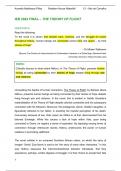Auerello Matthaeus Pillay Reddam House Waterfall 12 – Mrs de Carvalho
IEB 2022 FINAL – THE THEORY OF FLIGHT
QUESTION 5:
Read the following:
"In the novel it is shown that despite wars, violence, and the struggle for power
throughout history, human beings are connected across time and space – by their
stories of hope."
– Dr Miriam Wallraven
[Source: The Poetics of Interconnection in Postmodern Literature in a Global Age, Eberhard Karls
University, Germany <https://revistia.org>]
TOPIC:
Critically discuss to what extent Ndlovu, in The Theory of Flight, presents human
beings as being connected by their stories of hope despite living through war
and violence.
Unravelling the depths of human connection, The Theory of Flight, by Siphiwe Gloria
Ndlovu, presents human beings as being connected by their stories of hope despite
living through war and violence. In the novel, this is evident in Golide Gumede’s
materialisation of his Theory of Flight despite colonial constraints and his subsequent
connection with his followers. Moreover, the protagonist, Genie, Golide’s daughter, is
figuratively tethered to her father, in enacting her hopeful perception of his death.
Conversely, because of war, Vida ‘Jesus’ de Villiers is, at first, disconnected from his
beloved Everleigh. While this causes a lack of hope within Vida, upon being
connected to Genie, he regains a sense of aspiration. By depicting varying forms of
connection through interwoven stories, Ndlovu underscores the power of human
relations in promoting upliftment.
The novel unfolds in an unnamed Southern African nation, on which the story of
Imogen ‘Genie’ Zula Nyoni is said to be “the story of many other characters.” In this
way, Ndlovu espouses the interconnectedness between individuals, that they
experience, perhaps, similar degrees of struggle; it is their choice to accept their fate
1




